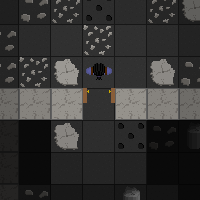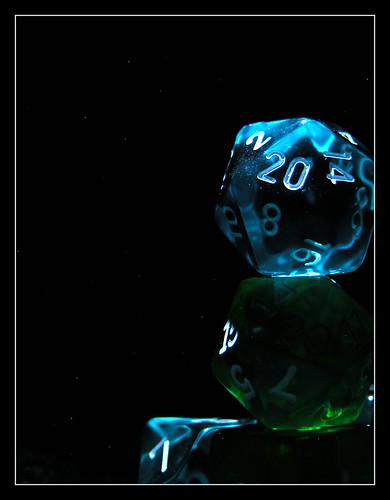My latest column was just put up at GameSetWatch. It’s called “Grim Fandango and Diegesis,” and it’s about how that game eschews interface elements that don’t exist in the game world.
Category Archives: Blogs
The Terror of Choice
As I sat at my desk sketching out a puzzle structure for my next game and listening to the latest episode of Radiolab, “Choice,” I started to think about complexity in goal trees. Just about any game’s structure can be represented as a tree (a partially-ordered set, really) of goals, some of which are required before others.
For the simplest of games, this tree consists of a straight line of nodes labeled something like “Reach Checkpoint 1,” “Reach Checkpoint 2,” and “Beat Boss.” Games with a hint of nonlinearity, however, can often have rather complicated goal trees. The simple tree has a branching factor of one. Each action, or node, has only one successor action. The game Planescape: Torment, on the other hand, has a branching factor of more than ten in some places, such as just after the player reaches the Clerk’s Ward. There are many the player can go or quests she can pursue, each separate and rather complex in its own right.
I’ve been playing The Elder Scrolls IV: Oblivion lately, and that is a game with a branching factor. Each town has four or more quests connected to it, in addition to the main quest, which itself sometimes branches into subquests. Add to this the guilds, of which there are at least four, and the game gets a bit intimidating for me. I hesitate to even mention the plugins and expansions. I walked through the door to the Shivering Isles, a whole new country with its own central plot, towns and sidequests. I think I lasted about fifteen minutes before I retreated back to Cyrodiil, overwhelmed. Oblivion‘s branching factor is a bit too large for my tastes. So what, then, is the optimal branching factor? Let’s look at some examples.
Creating Within a Genre

In the past, I’ve railed against the uselessness of game genres. They’re restrictive and arbitrary categorizations of games, and lead to design decisions being made according to convention rather than the needs of the game. However, sometimes a game is produced that depends wholly on the genre, doing nothing innovative, yet succeeds at being a stellar game in its own right. One of these games is The Curse of Monkey Island.
Fumbling Critical Rolls and the LORE Approach
Many tabletop roleplaying games and many digital games have a game mechanic called the “critical roll.” With this mechanic, a particularly good skill roll, say a 20 on a 20-sided die, can be a “critical hit,” which is better than a normal success. Likewise, a roll of 1 on a 20-sided die could be a “critical failure,” a “critical miss,” a “fumble,” or a “botch.” Critical failures result in an especially bad outcome.
Critical rolls typically represent the fickle hand of luck. Even in a game where randomness determines every important outcome, it is possible for characters to get especially lucky or unlucky. Sometimes, that arrow flies just right and hits the dragon right in the eye. Critical hits are often a cause for celebration among tabletop roleplayers, and critical misses are moments of frustration and (usually good-natured) anger at the game and the game master. Many digital games that use tabletop RPG-like mechanics also use critical roll systems. Notably, the action-focused game Team Fortress 2 also incorporates this mechanic in the form of random critical shots, which do more damage than normal shots and are more likely the more damage a player does.
Like many tabletop roleplayers, I’m working on a roleplaying system of my own, called LORE. During the development process, I’ve done a lot of thinking about a lot of the common elements of tabletop RPGs, and critical rolls has been one that I’ve focused on. I’ve decided that critical rolls have a part to play in game mechanics, but that there are many pitfalls that should be avoided. Here are my thoughts.
Continue reading Fumbling Critical Rolls and the LORE Approach
The Length of Games and the Frailty of Memory
Recently, GameSetWatch linked to an article at You Are Lose! asking if a long game can tell an engaging story:
When RPGs or strategy games stretch into the dozens of hours, played over many weeks or months, how am I to be expected to recall something that happened in the beginning of the game?
The longer a game, the more likely I am to put it down for a lengthy time and forget major details about it. This is a major detriment, I think, to games’ ability to tell a story.
The author, Korey, makes a certain amount of sense. As he points out, many games will present information in the opening cutscene that’s not referred to again until hours later. In the middle, there’s a whole lot of content going on. However, I think that when interactive narrative is handled properly, works of equivalent scope need to be longer than their non-interactive equivalents. Let’s look at Valve’s Portal first.
Continue reading The Length of Games and the Frailty of Memory
An Update on Myself
I’ve been a bit lax in posting lately, for a variety of reasons. To make up for it, I thought I’d give an update on my game development progress. Necropolis has been played over 58,000 times, according to my statistics on MochiAds. It has a rating of 3.04 out of 5 on Kongregate, which I think is quite fair considering its simplicity and apparent instability on some systems.
I’ve got another game, Sugarcore, up for bidding at FlashGameLicense.com. I’ve gotten no sponsorship bids or feedback on it there, which is a bit disappointing, as I think it’s a much better game than Necropolis. Still, it’s only been up two weeks, and the sources I’ve consulted suggest that it can take a month or more to get a bid. I’ve got my fingers crossed. If you happen to run a Flash portal interested in sponsoring a game, or if you’re an eccentric millionaire with a penchant for candy, let me know.
My next game, (I Fell In Love With) The Majesty of Colors, is in development. It’s coming along slowly, but I should hopefully finish it by the end of the week. You can see a mockup of the graphics here; it already looks a bit different from that, but the general look and feel is very close to the original concept in that image.
The Space Beyond the Rules
I just had an annoying conversation with a friend about the relative merits of Dungeons & Dragons Fourth Edition versus the previous version of the game. I’ll spare you the details, as it’s been discussed ad absurdum elsewhere. It did get me thinking, though, about the role rules play in tabletop roleplaying games.
Tabletop roleplaying games, as I’ve mentioned before, can adapt to players’ actions much more easily and completely than digital games. This is due mostly to the GM‘s ability to roll with the punches and make up stuff in response to an unexpected path taken by the party. Since the origin of tabletop roleplaying games, the roleplaying proper, that is, the social interaction, character quirks, and people-focused play, has been largely separate from the rules. Tabletop RPG rules focus on things like combat, non-social conflict resolution, and supernatural powers. All the fluffy social and character-building stuff is allowed to just occur, with the rules keeping out of its way. Sure, there might be a Diplomacy skill or a Charisma statistic, but those are usually reserved for small parts of the roleplaying: deciding if a character’s argument was convincing enough, or just how pretty the elf princess is. Few systems dedicate more than a page or two to rules governing seemingly important things like falling in love or becoming homesick.
And that’s just fine. Combat, magic, disabling booby traps: these are things that most of us will never experience, things which are nice to have codified and defined for easy processing. Social behavior, however, is something that’s familiar to every tabletop gamer. Even the most reclusive, introverted dice-roller has the experience of getting together with people around a table to play. Human beings understand social situations better than just about anything else, so our creativity is broader and deeper in that area. And I think that’s the interesting part of roleplaying.
The Most Important Games
“The 99th” over at Play This Thing! posted a list of the top ten most important games in history. It includes such things as family, fiat money, and Passage. I’ve got issue with a lot of things about this list.
First, as with most top ten lists, there is an issue of definition. What is a game? The much-lauded Chris Crawford has claimed that a game must be made for money, must have a goal, and must allow you to attack your opponent, among other things. By this definition, The Sims, Tetris, and the original release of Cave Story are not games. Many other definitions of games include “fun,” “play,” or “artificial,” although mathematical game theorists would vehemently argue otherwise. Let’s see if we can come up with a definition in the spirit of The 99th’s list.
For the purposes of this post, a “game” is a goal-oriented activity with artificially-established rules that are shared among multiple participants, called “players.” Players need not play simultaneously or adversarially. By “historically important,” I choose to mean “most significantly contributed to and/or were most necessary for the existence of the sort of games I discuss on this site.” As an initial disclaimer: I am not a historian. Now, for my version of The 99th’s list.
The 1UP Show

The 1UP Show does the best “traditional” digital games journalism around. Their latest episode has a review of Dead Space at around 26:13 that’s a perfect example of why this is.
Several folks who know their way around games sit and actually discuss the game. There’s no mention of a review score, but this is definitely a review, as it’s focused on the questions “how good is this game?” and “should people buy it?” The advantages over print media are obvious: you can see video of the game to illustrate their points, and you can see the reviewers as they say things, so that you can get a feeling for their attitudes and motivations. I had fun figuring out how the different people were approaching the game. This is all speculation, of course, but here are my thoughts. It was a little microcosm of all of digital games fandom.
Necropolis

I’ve decided to try my hand at Flash game development. It’s always been a dream of mine to make a living at creating games, and Flash games seem to be a viable way for individual, independent developers to earn a living.
My first game has just been released, thanks in part to a sponsorship from MiniJuegos.com. It’s a truly global market when a Spanish-language games site headquartered in Spain can fund an English-language game from one guy in North Carolina.
Necropolis is a game about Ms. Lilian Trevithick, lady adventurer and radical steam technician, who has come to the infamous Necropolis of Ao in search of adventure. She descends through 25 procedurally-generated levels of traps and treasure to achieve her goal.
Please give me any comments, compliments, or criticisms that come to mind playing the game! This is the first game I’ve released in years, so I’m both very nervous and very excited.
